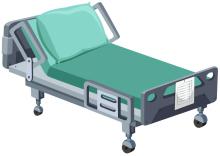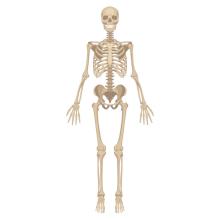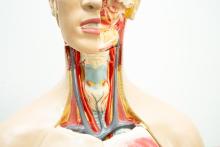Recent Publications

Avi Benov: Remote Damage Control Resuscitation: A Case Report of Hemorrhagic Shock Secondary to Multiple Gunshot Wounds (Mil Med . )
Hypovolemic shock is the leading cause of preventable death on the battlefield. Remote damage control resuscitation has evolved dramatically in the past decade by introducing novel treatments and approaches to bleeding in the prehospital setting. This report presents a case of a casualty who sustained multiple gunshot wounds to the chest and gluteal regions and suffered from hemorrhagic shock with an Injury Severity Score of 34.

Edo Y Birati: Predicting, Recognizing, and Treating Right Heart Failure in Patients Undergoing Durable LVAD Therapy (J Clin Med .)
Despite advancing technology, right heart failure after left ventricular assist device implantation remains a significant source of morbidity and mortality. With the UNOS allocation policy change, a larger proportion of patients proceeding to LVAD are destination therapy and consist of an overall sicker population. Thus, a comprehensive understanding of right heart failure is critical for ensuring the ongoing success of durable LVADs. The purpose of this review is to describe the effect of LVAD implantation on right heart function, review the diagnostic and predictive criteria related to right heart failure, and discuss the current evidence for management and treatment of post-LVAD right heart failure.

Ortal Calfon-Peretz, Rachel Weitzman, Abraham O Samson: Reply to van der Pluijm et al. Comment on "Weitzman et al. Resistance to Antimalarial Monotherapy Is Cyclic. J. Clin. Med. 2022, 11, 781" (J Clin Med . )
Thank you for the opportunity to respond to comments gracefully raised by van der Pluijm et al. [1] and referring to our paper titled: “Resistance to antimalarial monotherapy is cyclic."...

David Karasik: General and abdominal obesity operate differently as influencing factors of fracture risk in old adults (iScience . )
To infer the causality between obesity and fracture and the difference between general and abdominal obesity, a prospective study was performed in 456,921 participants, and 10,142 participants developed an incident fracture with follow-up period of 7.96 years. A U-shape relationship was observed between BMI and fracture, with the lowest risk of fracture in overweight participants.

Ala Aiob, Karina Naskovica, Inna Amdur Zilberfarb, Avishalom Sharon, Jacob Bornstein, Lior Lowenstein: Changes in diagnostic sensitivity, incidence and presentation of complete and partial hydatidiform mole over the years (Eur J Obstet Gynecol Reprod Biol
Molar pregnancy is the most common type of gestational trophoblastic disease. Several recent reports have described changes in the clinical representation, the incidence and the diagnostic sensitivity of molar pregnancy. These changes could be due to widespread use of transvaginal ultrasound and beta-hCG testing in the management of routine first-trimester investigations. This is a retrospective study of 144 women diagnosed with partial or complete mole at a regional medical center during 2007-2020.

Khalaf Kridin, Keren Lyakhovitsky, Erez Onn: Investigating the epidemiological relationship between vitiligo and psoriasis: a population-based study (Arch Dermatol Res .)
The association of vitiligo with psoriasis is inconsistent in the current literature. Assess the bidirectional association between vitiligo and psoriasis.

Khalaf Kridin: The association of six autoimmune bullous diseases with thyroid disorders: A population-based study (J Eur Acad Dermatol Venereol .)
The association of autoimmune bullous diseases (AIBDs) with thyroid disorders remains to be profoundly investigated. Evaluates the epidemiological association between six AIBDs and thyroid disorders.

Lilach Malatskey, Jumanah Essa-Hadad, Reut Eldar, Inna Filipov, Sophia Eilat-Tsanani, Mary C J Rudolf: Medical student lifestyle counselling for non-communicable disease: impact on students' competence and patients' health behaviors (Isr J Health Policy R
Promoting healthy lifestyle is key to tackling lifestyle-induced diseases, yet many doctors feel unskilled and medical schools lack its inclusion in their curricula. The impact of a novel elective lifestyle course is described, where students provided 3 months' coaching to at-risk patients.

Shaul Atar: Peripheral Arterial Disease in Patients With Acute Coronary Syndrome: Results From a Large Real-World Registry (Heart Lung Circ .)
Limited data exist regarding the significance of peripheral arterial disease (PAD) in patients with acute coronary syndrome (ACS). We evaluated 16,922 consecutive ACS patients who were prospectively included in a national ACS registry. The co-primary endpoint included 30 days major adverse cardiovascular event (MACE) (re-infarction, stroke, and/or cardiovascular death) and 1-year mortality.

Hiba Zayyad: Hospitalised patients with breakthrough COVID-19 following vaccination during two distinct waves in Israel, January to August 2021: a multicentre comparative cohort study (Euro Surveill .)
Changing patterns of vaccine breakthrough can clarify vaccine effectiveness. Compares breakthrough infections during a SARS-CoV-2 Delta wave vs unvaccinated inpatients, and an earlier Alpha wave.

Offer Amir: Effects of sildenafil on symptoms and exercise capacity for heart failure with reduced ejection fraction and pulmonary hypertension (The SilHF study): A randomised placebo-controlled multicentre trial (Eur J Heart Fail .)
Pulmonary hypertension (PHT) may complicate heart failure with reduced ejection fraction (HFrEF) and is associated with a substantial symptom burden and poor prognosis. Sildenafil, a phosphodiesterase-5 (PDE-5) inhibitor, might have beneficial effects on pulmonary haemodynamics, cardiac function and exercise capacity in HFrEF and PHT. Determines the safety, tolerability, and efficacy of sildenafil in patients with HFrEF and indirect evidence of PHT.

Anton Ouryvaev, Anca Leibovici, Luiza Akria, Dimitry Goncharov, Neomi Mativ, Avia Kauffman, Ayelet Shai: The Effectiveness and Safety of Medical Cannabis for Treating Cancer Related Symptoms in Oncology Patients (Front Pain Res (Lausanne) .)
The use of medical cannabis (MC) to treat cancer-related symptoms is rising. However, there is a lack of long-term trials to assess the benefits and safety of MC treatment in this population. In this work, we followed up prospectively and longitudinally on the effectiveness and safety of MC treatment.

Amir Mari: Advances on Neurogastroenterology and Motility Disorders: Pathophysiology, Diagnostics and Management (J Clin Med .)
Symptoms related to abnormalities in gastrointestinal tract motility and functions are very common in the general population, affecting both pediatrics and adults, from both sexes [...]. Editorial

Offer Amir: Changes in voice patterns for monitoring heart failure deterioration (EuroIntervention . )
Heart failure (HF) affects >6 million adults in the United States1 and 26 million worldwide2, at a cost of over $30 billion in the United States alone3. Pulmonary congestion is the predominant factor leading to hospitalisation for HF patients, and also is a major contributor to poor outcomes after hospital discharge. A need exists for a simple, non-invasive approach to detecting worsening pulmonary congestion at an early stage for the management of HF patients. In the context of pulmonary congestion, it has been proposed that the fluid overload may be detected by distinctly altered phonation patterns.

Elias Hellou, Ameer Elemy, Fahed Hakim: Effect of ArtemiC in patients with COVID-19: A Phase II prospective study (J Cell Mol Med . )
Despite intensive efforts, there is no effective remedy for COVID-19. Moreover, vaccination efficacy declines over time and may be compromised against new SARS-CoV-2 lineages. Therefore, there remains an unmet need for simple, accessible, low-cost and effective pharmacological anti-SARS-CoV-2 agents. ArtemiC is a medical product comprising artemisinin, curcumin, frankincense and vitamin C, all of which possess anti-inflammatory and anti-oxidant properties. The present Phase II placebo-controlled, double-blinded, multi-centred, prospective study evaluated the efficacy and safety of ArtemiC in patients with COVID-19.



